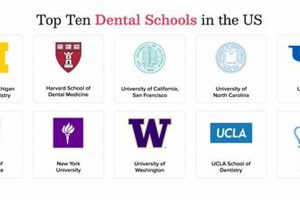Highly ranked undergraduate engineering programs with smaller student populations offer distinct advantages. These institutions frequently provide more personalized instruction, increased access to faculty, and a close-knit community fostering collaboration. Students may find opportunities for undergraduate research and hands-on learning experiences are more readily available in such settings. For example, a small school might offer specialized labs or equipment access typically reserved for graduate students at larger universities.
The emphasis on individual attention and community can significantly impact student success. Mentorship opportunities with professors and close interaction with peers create a supportive learning environment. This focused atmosphere can lead to enhanced academic performance, stronger professional networks, and greater career preparedness. Historically, many renowned engineering innovators emerged from smaller, specialized institutions that fostered close faculty-student relationships and provided unique learning opportunities.
Factors to consider when evaluating these institutions include program accreditation, specific engineering disciplines offered, faculty expertise, available resources, and career placement outcomes. The following sections will explore these considerations in greater detail to provide a comprehensive guide for prospective students.
Tips for Selecting an Undergraduate Engineering Program at a Smaller Institution
Choosing the right undergraduate engineering program is a pivotal decision. Careful consideration of specific factors can help prospective students identify institutions that align with their academic and career goals. The following tips offer guidance for navigating the selection process, particularly when focusing on smaller colleges and universities.
Tip 1: Research Program Accreditation: Ensure the program holds accreditation from a recognized body, such as ABET (Accreditation Board for Engineering and Technology). Accreditation signifies that the program meets rigorous quality standards and provides a solid educational foundation.
Tip 2: Evaluate Specific Disciplines: Smaller institutions may specialize in particular engineering fields. Carefully examine the curriculum and faculty expertise to ensure alignment with specific areas of interest, such as civil, mechanical, electrical, or chemical engineering.
Tip 3: Investigate Faculty Expertise: Look into the faculty’s research interests, publications, and industry experience. Smaller schools often offer opportunities for close interaction with professors, providing valuable mentorship and research opportunities.
Tip 4: Assess Available Resources: Consider the availability of specialized laboratories, equipment, and research facilities. While smaller institutions may have fewer overall resources than larger universities, some offer unique access to cutting-edge technology in specific niches.
Tip 5: Explore Career Placement Outcomes: Research the career paths of graduates. Investigate internship opportunities, job placement rates, and alumni networks to gauge the program’s effectiveness in preparing students for successful careers.
Tip 6: Consider Campus Culture and Environment: Visit the campus, if possible, to experience the learning environment and interact with current students and faculty. A smaller school’s close-knit community can be a significant advantage for some students.
Tip 7: Analyze Class Size and Student-Faculty Ratio: Smaller class sizes generally lead to increased individual attention from faculty and greater opportunities for student participation.
Tip 8: Evaluate Financial Aid and Scholarship Opportunities: Explore the financial aid options available at each institution to determine affordability and potential return on investment.
By carefully considering these factors, prospective students can identify smaller institutions offering high-quality engineering programs that align with their individual needs and aspirations. A well-informed decision maximizes the likelihood of a rewarding academic experience and successful career launch.
The next section will offer concluding thoughts on the value and potential of smaller institutions for aspiring engineers.
1. Personalized Attention
Personalized attention represents a cornerstone of the educational experience at smaller engineering schools. The lower student-to-faculty ratio fosters an environment where individual student needs are recognized and addressed, contributing significantly to academic success and professional development.
- Mentorship and Advising
Faculty in smaller institutions often serve as mentors, providing guidance beyond academics. This personalized advising can help students navigate course selection, research opportunities, and career paths. For instance, a professor might connect a student interested in robotics with a relevant research project or internship, fostering personalized skill development.
- Enhanced Classroom Interaction
Smaller class sizes facilitate more frequent and meaningful interaction between students and professors. This dynamic allows for individualized instruction, tailored feedback, and deeper exploration of course material. Students struggling with a particular concept, for example, can receive immediate clarification and support.
- Accessibility of Faculty
Professors at smaller institutions are typically more accessible outside of classroom hours. This availability allows students to seek additional help, discuss research ideas, or explore career options in a one-on-one setting. This readily available support system can be particularly beneficial for students transitioning into the demanding field of engineering.
- Tailored Learning Opportunities
Smaller institutions often offer opportunities for customized learning experiences. Independent study projects, specialized research opportunities, and close collaboration with faculty on real-world projects allow students to pursue individual interests and develop specialized skills. This tailored approach prepares students for diverse career paths and graduate study.
The personalized attention available at smaller engineering schools cultivates a supportive and engaging learning environment. This individualized approach contributes significantly to student success, fostering deeper understanding, greater confidence, and enhanced career preparedness within the challenging field of engineering. This focus on individual growth distinguishes smaller institutions and positions graduates for success in a competitive landscape.
2. Faculty Accessibility
Faculty accessibility represents a significant advantage offered by smaller engineering schools. Direct interaction with professors contributes substantially to student learning, professional development, and overall academic success. This accessibility fosters a mentoring environment often absent in larger institutions where large class sizes and demanding research schedules limit faculty interaction.
Enhanced faculty interaction translates into several tangible benefits. Students gain opportunities for individualized instruction, receiving tailored feedback and clarification on complex concepts. This personalized attention can be particularly crucial in demanding fields like engineering, where mastering foundational principles is essential for advanced study. Furthermore, accessible faculty can provide valuable career guidance, connecting students with internships, research opportunities, and professional networks. For example, a professor might mentor a student through a challenging research project, fostering critical thinking skills and contributing to a stronger graduate school application. Direct access to faculty expertise also allows students to explore specialized interests, leading to independent study projects and deeper engagement with specific engineering disciplines.
Cultivating strong faculty-student relationships is a hallmark of smaller engineering programs. This close interaction fosters a supportive learning environment, encourages active participation, and promotes a deeper understanding of the subject matter. While larger institutions may offer a broader range of resources, smaller schools often prioritize individual attention and mentorship, creating an environment where students feel comfortable seeking guidance and support. This accessibility contributes significantly to student satisfaction, academic achievement, and long-term career success, demonstrating a key advantage of smaller engineering programs. The ability to build meaningful relationships with experienced professionals in the field provides invaluable support and guidance throughout a student’s academic journey and beyond.
3. Stronger Community
A stronger sense of community frequently distinguishes smaller engineering schools from larger universities. This close-knit environment fosters collaboration, peer support, and a shared sense of purpose, contributing significantly to student success and overall well-being. Smaller cohorts facilitate more frequent interaction among students, creating opportunities for teamwork on projects, studying together, and sharing experiences. This collaborative atmosphere can be particularly beneficial in the demanding field of engineering, where students can learn from each other and navigate challenges collectively. For example, study groups can provide valuable peer-to-peer learning, while collaborative projects can simulate real-world engineering team dynamics.
Beyond academic collaboration, a stronger community cultivates a sense of belonging and mutual support. Students are more likely to form close relationships with their peers and faculty, creating a network of support that extends beyond the classroom. This supportive environment can be crucial for navigating the challenges of a rigorous engineering curriculum and fostering a sense of connection within the institution. This sense of belonging often translates into increased student engagement, higher retention rates, and a greater sense of overall satisfaction with the educational experience. Alumni networks from smaller schools also tend to be tightly knit, offering valuable professional connections and mentorship opportunities for graduates. This ongoing support can be instrumental in career advancement and provides a sense of continuity long after graduation.
The strong sense of community in smaller engineering schools fosters a supportive and enriching learning environment. This close-knit atmosphere contributes not only to academic achievement but also to the development of essential professional skills such as teamwork, communication, and networking. These combined benefits position graduates for success in their careers and beyond, highlighting the practical significance of a strong community within smaller engineering institutions. While larger universities may offer a broader range of resources, smaller institutions often excel in fostering a personalized and supportive environment crucial for student success, underscoring the value of community in engineering education.
4. Unique Research Opportunities
Smaller engineering schools often provide unique research opportunities not readily available at larger institutions. These opportunities stem from several factors, including lower student-to-faculty ratios, specialized faculty expertise, and a greater emphasis on undergraduate involvement in research. This access allows undergraduates to gain hands-on experience, contribute meaningfully to ongoing projects, and develop advanced skills typically reserved for graduate students at larger universities. For instance, a student at a smaller institution might work directly with a professor specializing in renewable energy, contributing to the development of new solar cell technology. This direct involvement provides valuable practical experience, strengthens the student’s research portfolio, and enhances their competitiveness for graduate programs or industry positions.
The benefits of undergraduate research extend beyond skill development. Participating in research fosters critical thinking, problem-solving abilities, and a deeper understanding of the scientific process. Students learn to formulate research questions, design experiments, analyze data, and communicate their findings effectively. These experiences cultivate intellectual curiosity and provide a solid foundation for future academic or professional pursuits. Moreover, undergraduate research experiences can significantly enhance a student’s graduate school application, demonstrating a commitment to the field and a capacity for independent inquiry. For example, presenting research findings at conferences or co-authoring publications can significantly strengthen a student’s credentials. Furthermore, smaller institutions often encourage interdisciplinary research, allowing students to explore connections between engineering and other fields, such as biology, chemistry, or computer science, broadening their perspectives and fostering innovation.
In summary, access to unique research opportunities represents a significant advantage of smaller engineering schools. These experiences foster practical skills, cultivate critical thinking, and enhance career prospects. The ability to engage in meaningful research as an undergraduate provides a distinct advantage in a competitive academic and professional landscape. While larger institutions may offer a wider range of research areas, smaller schools often provide more direct access and greater mentorship, creating an environment conducive to undergraduate research and fostering the next generation of engineering innovators. This emphasis on hands-on learning and close faculty-student collaboration distinguishes smaller institutions and contributes significantly to student success in engineering.
5. Specialized Programs
Specialized programs often distinguish best small schools for engineering, offering focused curricula and research opportunities within specific sub-disciplines. This specialization allows institutions to cultivate expertise and resources in niche areas, providing students with in-depth knowledge and practical experience not readily available in broader engineering programs. For example, a small school might specialize in biomechanical engineering, offering state-of-the-art laboratories and faculty expertise focused on this specific area. This focused approach can lead to enhanced learning outcomes and prepare students for specialized career paths.
The connection between specialized programs and the success of small engineering schools lies in their ability to cater to specific student interests and industry demands. By focusing resources on niche areas, these institutions can attract top faculty in those fields and develop cutting-edge research programs. This specialization often translates into stronger industry partnerships, creating valuable internship and career opportunities for graduates. For instance, a school specializing in robotics might collaborate with local robotics companies, providing students with real-world experience and a direct pathway to employment. This alignment between academic specialization and industry needs enhances the practical relevance of the education and contributes to the overall success of both students and the institution.
In summary, specialized programs contribute significantly to the distinction of best small schools for engineering. This focused approach allows for concentrated expertise, enhanced learning outcomes, and stronger industry connections. By catering to specific student interests and industry demands, these institutions provide a unique educational experience that prepares graduates for specialized and in-demand careers. The strategic development and maintenance of specialized programs within a smaller institutional setting can, therefore, represent a key factor in achieving excellence in engineering education.
6. Industry Connections
Strong industry connections represent a crucial component of high-quality engineering programs, particularly within smaller institutions. These connections provide a bridge between academic learning and practical application, enriching the educational experience and enhancing career prospects for graduates. Close relationships with industry partners offer numerous benefits, including access to internships, real-world projects, and guest lectures from practicing engineers. These experiences provide students with valuable insights into current industry trends, challenges, and best practices, supplementing theoretical knowledge with practical skills and professional networking opportunities. For example, a partnership with a local aerospace company might provide students with internships working on aircraft design projects, offering invaluable hands-on experience and exposure to a professional engineering environment.
The practical significance of industry connections lies in their direct impact on career outcomes. Students who gain practical experience through internships and industry projects are often more competitive in the job market upon graduation. These experiences not only demonstrate practical skills but also provide valuable networking opportunities, potentially leading to job offers or mentorship relationships. Furthermore, industry connections can inform curriculum development, ensuring that academic programs remain aligned with current industry needs and technological advancements. For instance, feedback from industry partners might lead to the incorporation of new software tools or design methodologies into the curriculum, enhancing the relevance of the education and preparing graduates for the demands of the modern workplace. Collaboration on research projects can also lead to innovation and the development of new technologies, benefiting both the institution and its industry partners.
In conclusion, strong industry connections are integral to the success of best small schools for engineering. These partnerships provide a vital link between academic theory and practical application, enriching the educational experience and enhancing career prospects for graduates. By fostering these connections, smaller institutions can provide students with a competitive edge, preparing them for successful and impactful careers in engineering. The cultivation and maintenance of these relationships represent a strategic investment in the future of engineering education and the ongoing advancement of the field.
7. Career Placement Success
Career placement success serves as a key indicator of the effectiveness and quality of engineering programs, especially within smaller institutions. Strong placement outcomes demonstrate the program’s ability to prepare graduates for successful entry into the professional workforce or acceptance into competitive graduate programs. This success stems from a combination of factors, including rigorous curricula, practical learning experiences, strong industry connections, and personalized career advising. For instance, a high placement rate in prestigious engineering firms or top-tier graduate programs suggests that the program effectively equips students with the necessary skills and knowledge to excel in their chosen fields. Smaller institutions often highlight successful alumni career paths as evidence of their program’s value and effectiveness. Successful career placement may manifest in various forms, such as securing employment in relevant engineering fields, obtaining competitive internships, or gaining admission to prestigious graduate programs. Real-life examples, such as a graduate securing a position at a leading aerospace company or being accepted into a top-ranked doctoral program, demonstrate the tangible impact of a successful engineering education.
The importance of career placement success as a component of “best small schools for engineering” stems from its practical significance for students. Prospective students often consider career outcomes when choosing an institution, recognizing the long-term impact of their educational investment. High placement rates and positive alumni career trajectories can signal a program’s effectiveness in preparing students for successful and fulfilling careers. Institutions with strong career services departments, active alumni networks, and established industry partnerships often exhibit higher placement success rates. These resources provide students with the necessary support and guidance to navigate the job market, connect with potential employers, and secure desirable positions upon graduation. The ability to connect classroom learning with practical applications through internships and research experiences significantly enhances career preparedness and contributes to successful placement outcomes. Further, the focus on specific engineering disciplines in some smaller institutions can lead to targeted career placement in specialized fields, further reinforcing the connection between program focus and career success.
In conclusion, career placement success serves as a critical metric for evaluating the quality and effectiveness of engineering programs at smaller institutions. Strong placement outcomes demonstrate the program’s ability to prepare graduates for successful careers in engineering or further academic pursuits. Factors such as rigorous curricula, practical learning experiences, strong industry connections, and personalized career advising contribute significantly to successful career placement. Prospective students recognize the importance of this metric, considering future career prospects when selecting an institution. By prioritizing career placement support and fostering strong connections with industry, best small schools for engineering demonstrate a commitment to student success and contribute to the overall advancement of the engineering profession. Challenges may include fluctuations in the job market or evolving industry demands, requiring institutions to adapt their programs and career services to maintain high placement rates and ensure continued relevance in a dynamic professional landscape.
Frequently Asked Questions
This section addresses common inquiries regarding undergraduate engineering programs at smaller institutions. The goal is to provide clarity and dispel potential misconceptions surrounding the unique advantages and challenges associated with these programs.
Question 1: Do smaller engineering programs offer the same breadth and depth of curriculum as larger universities?
While smaller institutions may not offer every specialized engineering discipline available at larger universities, they frequently provide focused expertise and in-depth curricula within specific areas. Accreditation ensures adherence to rigorous academic standards, and smaller class sizes can facilitate deeper exploration of core concepts.
Question 2: Are graduates from smaller engineering programs as competitive in the job market as those from larger universities?
Graduates from smaller programs can be highly competitive, often benefiting from personalized attention from faculty, close industry connections, and practical research experiences. These factors can lead to specialized skills and strong professional networks, enhancing career prospects.
Question 3: What are the advantages of smaller class sizes in engineering programs?
Smaller class sizes facilitate increased interaction with faculty, fostering personalized instruction, tailored feedback, and enhanced mentorship opportunities. This individualized attention can be particularly beneficial in demanding fields like engineering, where mastering complex concepts is crucial.
Question 4: Do smaller engineering schools offer adequate research opportunities for undergraduates?
Many smaller institutions prioritize undergraduate research, often providing access to specialized laboratories, equipment, and close collaboration with faculty on ongoing projects. This focus on hands-on learning can provide a distinct advantage, fostering practical skills and enhancing graduate school applications.
Question 5: What are the potential drawbacks of attending a smaller engineering school?
Potential drawbacks might include a more limited selection of specialized engineering disciplines compared to larger universities and fewer overall resources. However, the focused nature of smaller programs can also be a strength, fostering expertise in specific areas.
Question 6: How can prospective students determine if a smaller engineering program is the right fit?
Thorough research, including reviewing program accreditation, faculty expertise, available resources, and career placement outcomes, is essential. Visiting the campus, interacting with current students and faculty, and carefully considering personal learning preferences are crucial for making an informed decision.
Careful consideration of these factors provides prospective students with valuable insights into the unique benefits and potential challenges of pursuing an engineering education at a smaller institution. A well-informed decision should align individual academic and career goals with the specific offerings and environment of the chosen program.
For further information and resources, please consult the concluding section.
Best Small Schools for Engineering
Highly ranked, smaller institutions offering undergraduate engineering programs provide distinct advantages for students seeking personalized learning and close faculty interaction. This article explored key aspects of these programs, including the benefits of smaller class sizes, enhanced faculty accessibility, stronger community, unique research opportunities, specialized programs, robust industry connections, and successful career placement outcomes. These factors contribute significantly to a supportive learning environment and prepare graduates for successful careers in a competitive landscape. The potential for focused development in specific engineering disciplines, coupled with close mentorship and hands-on learning experiences, positions graduates from these institutions for impactful contributions to the field.
Careful consideration of individual learning preferences, career aspirations, and program-specific strengths remains paramount in selecting the optimal educational path. Prospective students are encouraged to thoroughly research institutions, engage with current students and faculty, and critically evaluate program offerings to identify the best fit. The choice of a smaller engineering program represents an investment in focused development and personalized learning, setting the stage for a fulfilling and impactful career in engineering.







